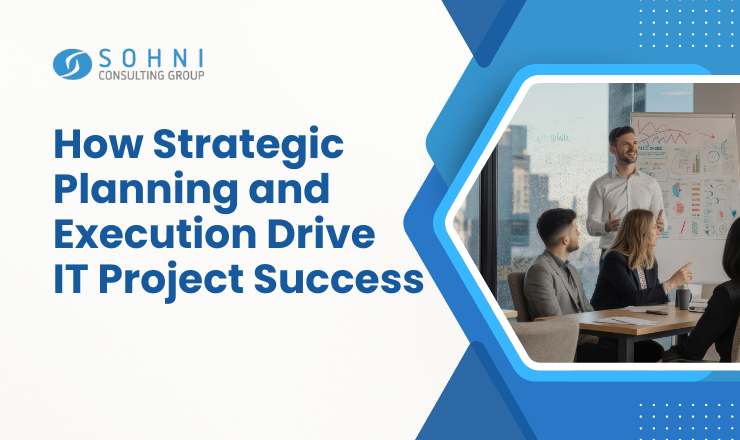- October 22, 2025
- Posted by: admin
- Category: Consultancy, Strategy Planning

In today’s fast-paced digital landscape, IT projects are no longer just about technology—they’re about strategy, value, and execution excellence. Many organisations invest heavily in tools and systems but fail to align their IT initiatives with clear strategic goals. That’s where effective strategy development and execution come in. When planned and executed correctly, they transform IT projects from simple implementations into business-driven success stories.
1. Strategy Development: Setting the Foundation for Success
Every successful IT project begins with a strong strategic foundation. This means defining clear objectives, identifying potential risks, and aligning project goals with business outcomes.
Strategy development involves understanding not only what technology can do but how it supports wider organisational priorities such as efficiency, scalability, and innovation.
Key elements of effective strategy development include:
– Establishing measurable goals and KPIs
– Aligning IT initiatives with long-term business strategy
– Building cross-functional collaboration between other departments
– Assessing risk and resource allocation early
A well-structured strategy ensures that the project team moves forward with a unified vision and clear success metrics.
2. Turning Strategy into Execution
While creating a strategy is essential, true impact lies in its execution. Strategy execution is about translating plans into actions, ensuring that every step is measurable and accountable.
Strong execution frameworks involve:
– Defined roles and responsibilities
– Agile project methodologies
– Transparent communication channels
– Continuous tracking and performance reviews
When execution is managed effectively, organisations experience better control, reduced delays, and higher project ROI.
3. Program Recovery and Optimisation: Getting Projects Back on Track
Not every IT project goes as planned. Scope creep, budget overruns, or shifting business priorities can derail even the most well-intentioned initiatives. That’s where program recovery and optimisation become essential.
Specialised recovery teams evaluate underperforming projects, identify the root causes of failure, and realign objectives with actionable strategies. Through optimisation, organisations can not only recover lost momentum but often exceed their original project goals.
This approach strengthens overall governance and restores confidence in delivery outcomes.
4. Training Management and Delivery: Empowering Teams for Long-Term Success
Even the best strategy and execution plans can fall short without skilled teams to drive them. Training management and delivery play a crucial role in equipping teams with the right technical, strategic, and communication skills needed to sustain performance.
By integrating tailored training programs throughout the project lifecycle, businesses can:
– Improve adoption of new systems and technologies
– Enhance collaboration between IT and business units
– Build leadership capacity for future initiatives
Training ensures that project benefits are not only achieved but sustained long after delivery.
5. The Continuous Improvement Mindset
The best IT projects don’t end at deployment—they evolve. A continuous improvement mindset encourages teams to assess outcomes, learn from challenges, and refine processes for future success.
This cycle of strategy development and execution ensures consistent innovation and adaptability in a constantly changing digital environment.
IT project success is built on more than technology—it’s about people, planning, and purposeful execution. By focusing on strategy development and execution, supported by program recovery and optimisation and training management and delivery, organisations can achieve long-term impact and measurable results.
If your organisation is looking to align IT initiatives with measurable outcomes or overcome delivery challenges, our experts can help you plan, execute, and optimise with confidence.
Get in touch with us today to discuss how we can support your next IT project.

